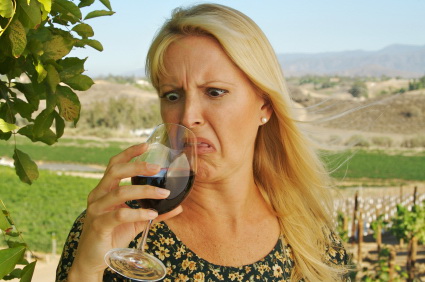 My head pounds. My lips burn. My teeth sting. How could I have been so naïve?
My head pounds. My lips burn. My teeth sting. How could I have been so naïve?
When the invitation arrived for “a tasting of one hundred blockbuster reds from the new vintage,” I was pleased, even a bit excited.
Now I feel as though I’ve spent two hours with a drill-crazed dentist who thinks anaesthetic is for wimps.
At this tasting, five local importers are showcasing their wines to a handful of writers. The room is thick with the sweet smell of alcohol.
On a long table in front of me are 65 bottles of powerhouse Australian shiraz. The next table has just as many robust Californian zinfandels.
Past that point, my field of vision blurs. To get through so many wines, I can’t spend more than a minute or so on each. I throw myself into the task anyway. It’s only 9 a.m.
I’d thought that a mass tasting would help me to better understand the style of this year’s crop, but what’s hitting me hardest is how alcoholic these wines are.
I’m already feeling hot under the collar with the first few samples. Don’t get me wrong: I like alcohol. It makes me happy, and stops me from being a tightly wound control freak as some people unjustly characterize me. (After we’ve shared a few glasses, I forgive these people.) 
Increasingly, though, I find that many wines today are too potent. To me, it’s simply alien when pinot noir tastes like port and I have to put it in the fridge before drinking it to numb the alcoholic heat.
If I just wanted booze, I’d have a martini.
But I drink wine for its taste, so the last thing I need is the blowtorch finish of bathtub gin. It’s also tiring on the palate and on the body.
After a few glasses of high-octane wine at home, I can’t taste food anymore. After dinner, when I watch CSI, I usually wake up just as they’re nailing the bad guy. I’m the victim of the wine’s blunt force trauma.
Yet wines haven’t always been this alcoholic. In the 1970s, for instance, two of the most popular wines were the German whites Blue Nun and Black Tower, with only 8 or 9 percent alcohol.
(Here are my top reviews of wines under 10% alcohol.)
Ten to 12 percent used to be the norm for reds. But in North America today, some blockbuster wines now go as high as 14 to 16 percent.
Why? One reason is changing consumer taste. In the 1980s, drinkers who’d become accustomed to strong cocktails started to prefer robust red wine.
Red wine grapes are usually picked later in the season than white ones, so the resulting wine is often more alcoholic.
What other factors are fuelling the trend? Is it vintner choices, wine critic ratings or some other reason? To answer these questions, it helps to understand first what alcohol is and what it does for wine.
Back in Europe in the fifteenth century, authorities determined alcoholic strength by dipping a rag soaked in wine, beer or spirit, and then lighting it. If it burned brightly, the liquid was alcoholic; if not, it was too dilute.
As a later refinement, they mixed gunpowder with the alcohol before lighting it. If it flamed, it was “proved” as alcohol; a small explosion was considered “strong proof.”
In the later 1700s, when governments started taxing alcohol based on its proof, precise measurement was needed.
French scientist Joseph Louis Gay-Lussac developed a formula to determine the percentage of pure ethanol in wine, using the recently invented hydrometer. Today’s European legal benchmark is 8.5-15 percent by volume; North America’s range is between 7 and 14 percent.
 Regardless of a wine’s style, alcohol is the skeleton that supports its texture, tannin, aroma and acidity. Alcohol is also a solvent that extracts flavor compounds from the grape juice and helps to make them airborne so we can smell the aromas.
Regardless of a wine’s style, alcohol is the skeleton that supports its texture, tannin, aroma and acidity. Alcohol is also a solvent that extracts flavor compounds from the grape juice and helps to make them airborne so we can smell the aromas.
When we swirl a glass of wine, alcohol coats the sides of the glass and then evaporates. This releases the wine’s fragrant organic compounds or, to use the jargon, it volatizes the esters.
Wine lovers refer to this coating of their glass as “tears” or “legs.” The higher the alcohol, the slower and more distinct the tears.
This doesn’t indicate a better wine, just a more alcoholic one. This vinous fact is even mentioned in the Bible: Proverbs 23, 31 advises the devout not to “gulp down the wine, the strong red wine when droplets form on the side of the cup.”
Maybe that’s what they mean by no more tears in heaven.
Although ethanol in wine is odorless and tasteless, it gives us the impression of sweetness. That’s why a full-bodied wine that’s completely dry can still taste sweet.
That may also be why high-alcohol wines are so popular: they’re technically “dry” and hence perceived as sophisticated, but they still taste like jam. We talk dry, but drink sweet.
On the palate, alcohol gives wine its body or weight—that luxurious, rounded texture called mouth-feel. Too little alcohol makes a wine feel thin and watery, like skim milk.
Too much makes it feel heavy and thick, like cream. But when alcohol is balanced with the flavor, tannins and acidity, the wine feels like whole milk.
So if the wine is balanced, some connoisseurs argue, high alcohol isn’t a problem. They also say that high alcohol is vital to wines with rich flavors and strong tannins, enabling it to be consumed without aging.
Otherwise, drinkers have to wait years for …
Continue to Part 2 of High Alcohol Wine







